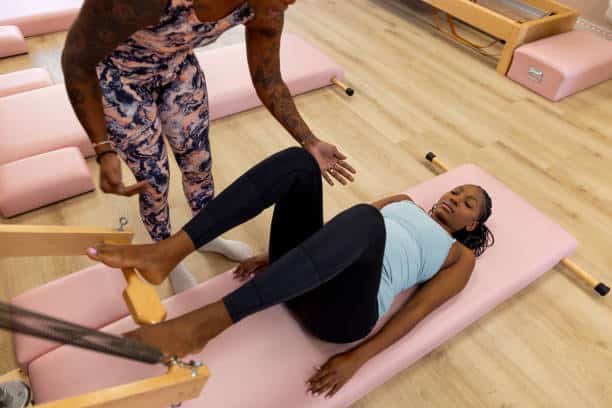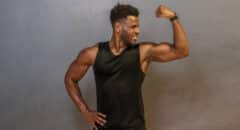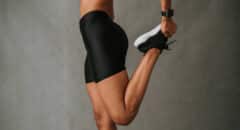
Pilates has often been portrayed in mainstream media as the domain of thin, affluent, mostly white clientele in upscale boutique studios. But a shift is underway: Black-owned Pilates studios are pushing back, redefining what Pilates looks like, who it’s for, and what it can represent. They are building inclusive spaces, elevating community identity, adapting movement to fit diverse bodies, and tackling systemic barriers head-on.
Rooting Pilates in Community & Identity
One of the most powerful forces driving Black-owned Pilates studios is the desire for representation, belonging, and identity affirmation. For many, taglines like “Pilates isn’t for me” aren’t just metaphors—they’re lived experiences. The lack of folks in the room who look like you or share your cultural background can make fitness feel alienating rather than empowering.
- Black Girl Pilates®, founded by Sonja R. Price Herbert in 2017, emerged from just such a need. Herbert felt unseen in the Pilates world—few Black instructors, few Black students, limited visibility or acknowledgement of Black contributions in Pilates history. Her organization now provides mentorship, networking, workshops, conferences, and events centered around Black women, affirming that Pilates is “for everyone and every body.”
- Prevailing Pilates in North Carolina is another example. Owner Sabrina Seymore built her studio precisely because she noted the narrow demographic that many studios served. She designed her space to welcome all body types, emphasize community, and affirm that Pilates isn’t just about aesthetic or elitist ideals—it’s also about strength, mobility, healing, and mental well-being.
These studios root their practice not just in movement, but in shared lived experience. Music choices, studio décor, and community rituals often attend to cultural style (e.g., playing R&B, using empowering language, building support around identity) so clients see themselves reflected and feel heard. That sense of belonging increases retention, trust, and healing.
RELATED: Pilates for Black Girls: A 30-Day Routine to Strengthen and Tone Your Body
Inclusive Class Designs & Payment Models
Reinventing Pilates also means dismantling the barriers around cost, class format, instructor identity, and scheduling. Many Black-owned studios have adopted inclusive designs to make Pilates more accessible, both financially and physically.
Payment & Class Design Innovations
- Some studios offer sliding scale pricing, scholarship spots, or lower-cost group classes — rather than premium-only or boutique pricing.
- Small-group reformer Pilates classes (instead of large, high-cost group classes) allow more instructor attention, corrections, and customization. For communities not used to high-end reformer pricing, this helps bridge the access gap. Prevailing Pilates and The Pilates Table are examples.
Inclusive Formats
- Studio sessions include all body shapes, sizes, ages, and physical abilities. Prevailing Pilates specifically emphasizes seeing “all body types,” rejecting the narrow ideal of “lean and thin” bodies.
- They adapt movement and cueing to be body-inclusive: modifications for mobility, strength variation, injury history, etc. The goal is not perfection but sustainability, healing, and functional fitness.
Accessibility of equipment
- Reformers are expensive; not all studios start with them. Some Black-owned studios begin with mat Pilates, props, and gradually scale up.
- Others collaborate with donors, community centers, or use shared spaces to reduce overhead. There’s also creative scheduling so that off-peak hours are lower cost for clients.

Stories from Black Pilates Instructors & Owners
Hearing the stories of Black Pilates instructors provides vivid insight into how individuals are shaping the change.
- Sabrina Seymore, owner of Prevailing Pilates, discusses setting up her studio during the COVID-19 recovery period. She noticed how many studios did not feel physically or culturally welcoming, and so she built one that does: with music selected by the class, sauna access, a welcoming environment for people of all body types, and a strong community feel.
- Amber Goin, owner of The Pilates Table in Cincinnati, opened the city’s first Black-owned reformer Pilates studio with six reformers. Her mission: make reformer Pilates more accessible, visibly inclusive, and less intimidating. Goin mentioned she rarely saw instructors who looked like her, nor did she see many clients from her own background in other studios, which propelled her to create this space.
- Sonja Herbert of Black Girl Pilates has built a community, mentorship, workshops, and an instructor directory with an explicit focus on elevating Black voices, knowledge, and aesthetics in Pilates. Her activism pushes the industry to name and celebrate Black Pilates histories — such as early Black Pilates elders like Kathleen Stanford Grant.
These stories show that for a lot of Black instructors and studio owners, Pilates isn’t just a job—it’s an act of reclamation, identity, and care for community.
Cross-Cultural Adaptations & Movement Fusions
Redefinition often comes through fusion: combining traditional Pilates with cultural movement, music, or modalities, adapting the aesthetic, or changing the teaching style to resonate with Black communities.
- Prevailing Pilates integrates music chosen collaboratively with students (R&B, rap, etc.), which shifts the vibe from traditional “fitness studio silence” to something more culturally familiar.
- Black Girl Pilates explicitly states that Pilates is “body, breath, core integration, movement, concentration, and focus” and emphasizes that it is for every body and condition. That means adapting for different abilities, strengths, and histories of movement (dance, mobility practice, healing movement).
- Studios are also reclaiming the narrative of what Pilates looks like: not always sleek, Instagram-perfect, or photoshoot-ready, but real bodies, real stories. This includes curvier bodies, older bodies, gender diversity, and people recovering from injury.
- Some instructors are fusing Pilates with yoga, physical therapy, dance, or mobility work, recognizing that many Black people come into wellness with varied movement backgrounds (dance, church walking, etc.), so fusions make Pilates feel more accessible and relevant.
RELATED: I Heard Pilates is in! 7 Reasons Black Women Should Consider Trying it

Challenges (Space, Equipment, Access) & How They Overcome
Despite the progress, Black-owned Pilates studios face considerable challenges. But many are finding creative ways to navigate them.
Space & Equipment
- High cost of equipment: Reformer machines, towers, and cadillacs are expensive to purchase and maintain. Many studios must start small or use mats or props until they have funding or revenue to support larger equipment.
- Studio space is expensive, especially in cities. Rent, insurance, and overhead make it hard to maintain affordable pricing while staying sustainable.
Access & Pricing
- Many traditional Pilates studios are boutique-priced ($30–$50+ per class), which excludes people with tighter budgets. Black-owned studios are increasingly using sliding scales, community classes, or tiered pricing to allow access. The Pilates Table, for example, focuses on boutique style but emphasizes small group instruction and more inclusive pricing.
- Location and transit access can be limiting. When studios are located far from public transportation or in more expensive neighborhoods, community members may find classes less accessible. Some studios respond by offering virtual classes or mobile offerings.
Instructor Representation & Certification Barriers
- Certification for Pilates instructor training is expensive and time-consuming, often requiring travel to disciplines or training that don’t include many Black instructors or mentors. This limits entry and results in fewer Black teachers.
- Black Girl Pilates is working to change that by offering mentorship, resources, networking, and building awareness of Black elders and history in Pilates training.
Solutions & Strategies
- Community funding, grants, and shared ownership: Some studios use crowdfunding, partner with wellness nonprofits, or operate in cooperative models.
- Sliding scales and scholarship spots: Offering reduced-price classes for those who can’t pay full price helps increase access without compromising mission.
- Hybrid/in-person plus virtual classes: Virtual allows folks who can’t commute or pay full in-studio fares. It also allows those with mobility, caregiving, or time constraints to participate.
- Local mentorship and pipelines: Black Pilates organizations, trainer networks, and mentorship programs help bring up new instructors, improving representation and reducing training costs via peer support.
Why This Matters: Beyond Fitness
Black-owned studios doing this work are not just changing Pilates—they are shifting how wellness, healing, and movement are experienced in Black communities. Here are some of the impacts:
- Healing & Self-Image: For many, seeing a body that looks like theirs in the mirror or among classmates changes how they feel about their own worth in wellness spaces. It combats the stigma that “Pilates is not for me.”
- Cultural preservation & identity: These studios often reference Black Pilates history (Kathleen Stanford Grant, etc.) and culture, bringing awareness to stories often omitted from the Pilates lineage.
- Physical & Mental Health Access: When people feel seen and comfortable, they’re more likely to attend consistently, which results in physical benefits (core strength, mobility, injury prevention, etc.) and mental benefits (community connection, stress relief).
- Shifting Industry Norms: As more Black-owned studios succeed and more instructors gain visibility, the expectations for what Pilates representation looks like begin to change. Marketing imagery changes, product lines adjust, and pricing norms come under scrutiny.
Black-owned Pilates studios are doing something powerful: reclaiming a physical practice as more than just fitness, making it a place of identity, representation, community, healing, and access. They are redesigning class formats, payment models, studio culture, and instructor pipelines. And while the challenges (from cost to space to perception) are significant, these studios are not just surviving—they’re reimagining what Pilates can be.









